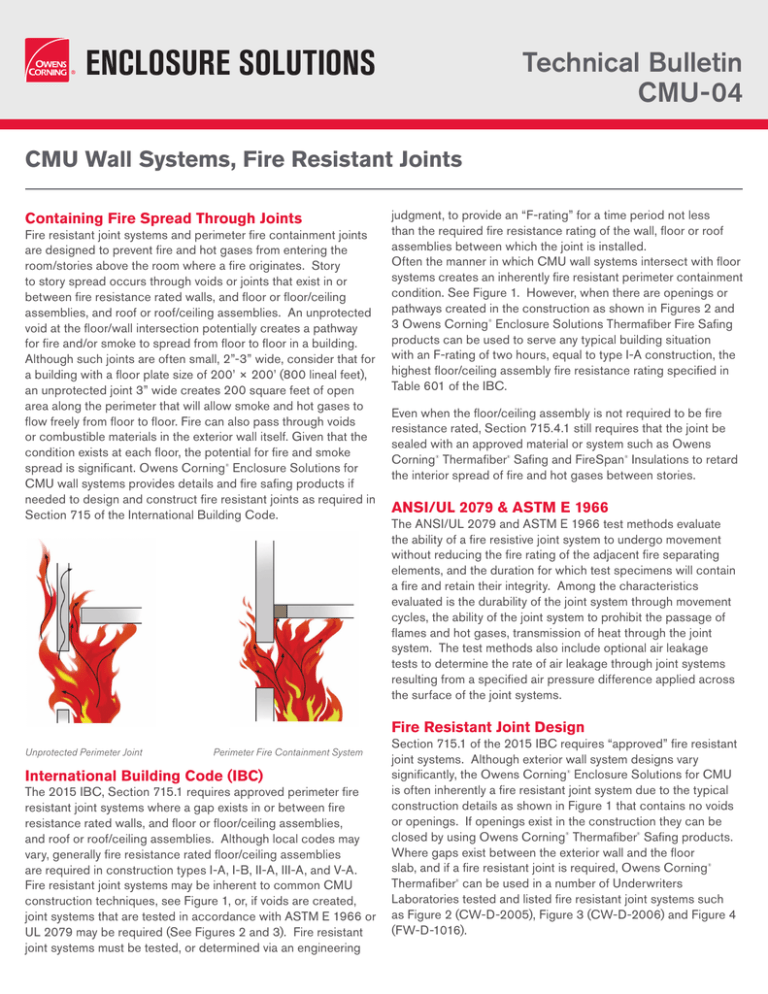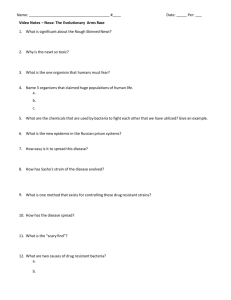
ENCLOSURE SOLUTIONS
Technical Bulletin
CMU-04
CMU Wall Systems, Fire Resistant Joints
Containing Fire Spread Through Joints
Fire resistant joint systems and perimeter fire containment joints
are designed to prevent fire and hot gases from entering the
room/stories above the room where a fire originates. Story
to story spread occurs through voids or joints that exist in or
between fire resistance rated walls, and floor or floor/ceiling
assemblies, and roof or roof/ceiling assemblies. An unprotected
void at the floor/wall intersection potentially creates a pathway
for fire and/or smoke to spread from floor to floor in a building.
Although such joints are often small, 2”-3” wide, consider that for
a building with a floor plate size of 200’ × 200’ (800 lineal feet),
an unprotected joint 3” wide creates 200 square feet of open
area along the perimeter that will allow smoke and hot gases to
flow freely from floor to floor. Fire can also pass through voids
or combustible materials in the exterior wall itself. Given that the
condition exists at each floor, the potential for fire and smoke
spread is significant. Owens Corning Enclosure Solutions for
CMU wall systems provides details and fire safing products if
needed to design and construct fire resistant joints as required in
Section 715 of the International Building Code.
®
judgment, to provide an “F-rating” for a time period not less
than the required fire resistance rating of the wall, floor or roof
assemblies between which the joint is installed.
Often the manner in which CMU wall systems intersect with floor
systems creates an inherently fire resistant perimeter containment
condition. See Figure 1. However, when there are openings or
pathways created in the construction as shown in Figures 2 and
3 Owens Corning Enclosure Solutions Thermafiber Fire Safing
products can be used to serve any typical building situation
with an F-rating of two hours, equal to type I-A construction, the
highest floor/ceiling assembly fire resistance rating specified in
Table 601 of the IBC.
®
Even when the floor/ceiling assembly is not required to be fire
resistance rated, Section 715.4.1 still requires that the joint be
sealed with an approved material or system such as Owens
Corning Thermafiber Safing and FireSpan Insulations to retard
the interior spread of fire and hot gases between stories.
®
®
®
ANSI/UL 2079 & ASTM E 1966
The ANSI/UL 2079 and ASTM E 1966 test methods evaluate
the ability of a fire resistive joint system to undergo movement
without reducing the fire rating of the adjacent fire separating
elements, and the duration for which test specimens will contain
a fire and retain their integrity. Among the characteristics
evaluated is the durability of the joint system through movement
cycles, the ability of the joint system to prohibit the passage of
flames and hot gases, transmission of heat through the joint
system. The test methods also include optional air leakage
tests to determine the rate of air leakage through joint systems
resulting from a specified air pressure difference applied across
the surface of the joint systems.
Fire Resistant Joint Design
Unprotected Perimeter Joint
Perimeter Fire Containment System
International Building Code (IBC)
The 2015 IBC, Section 715.1 requires approved perimeter fire
resistant joint systems where a gap exists in or between fire
resistance rated walls, and floor or floor/ceiling assemblies,
and roof or roof/ceiling assemblies. Although local codes may
vary, generally fire resistance rated floor/ceiling assemblies
are required in construction types I-A, I-B, II-A, III-A, and V-A.
Fire resistant joint systems may be inherent to common CMU
construction techniques, see Figure 1, or, if voids are created,
joint systems that are tested in accordance with ASTM E 1966 or
UL 2079 may be required (See Figures 2 and 3). Fire resistant
joint systems must be tested, or determined via an engineering
Section 715.1 of the 2015 IBC requires “approved” fire resistant
joint systems. Although exterior wall system designs vary
significantly, the Owens Corning Enclosure Solutions for CMU
is often inherently a fire resistant joint system due to the typical
construction details as shown in Figure 1 that contains no voids
or openings. If openings exist in the construction they can be
closed by using Owens Corning Thermafiber Safing products.
Where gaps exist between the exterior wall and the floor
slab, and if a fire resistant joint is required, Owens Corning
Thermafiber can be used in a number of Underwriters
Laboratories tested and listed fire resistant joint systems such
as Figure 2 (CW-D-2005), Figure 3 (CW-D-2006) and Figure 4
(FW-D-1016).
®
®
®
®
®
ENCLOSURE SOLUTIONS
Technical Bulletin
CMU-04
Underwriters Laboratories Joint
Design Numbering System
The systems are identified by alpha-numeric designations. The
first two characters, CW or FW indicate the joint system is used
for the interface between a floor and curtain wall, or, a floor and
wall respectively. The third character, S or D, identifies if the
joint system was tested for movement, “S” meaning static or not
tested for movement, and “D” meaning dynamic or tested for
movement. The number portion of the identification indicates
the maximum distance that the joint can span between the wall
and the edge of the floor. Numbers in the range of 000-999 are
less than or equal to 2”. 1000-1999 are less than or equal to 6”.
2000-2999 are greater than 6” and less than or equal to 12”.
Figure 2
Joint Ratings F, I, T, and L
The F-rating, or, Integrity rating, expressed in hours, indicates the
length of time that a fire resistant joint can withstand fire before
being consumed or before permitting the passage of flame
through the opening.
The T-rating, or, Insulation rating, expressed in hours, indicates
the length of time that the temperature on the non-fire side of the
penetration does not exceed 325 oF (163 oC) above the ambient
temperature. This ensures that the temperature on the side of the
wall away from the flame does not reach the flash point of any
materials on that side of the wall.
The L-rating (optional), expressed in cubic feet per minute, is the
amount of air (or cold smoke) that may leak through a penetration.
Movement Ratings
ANSI/UL 2079 requires that joint systems with movement
capabilities be cycled through the intended range of movement
prior to fire testing. Movement cycling is intended to stress
the joint design and test its durability while spanning between
the elements of the fire resistive assembly. Class I joints are
subjected to 500 cycles at 1 cycle per minute, Class II, 500
cycles at 10 cycles per minute, and Class III, 100 cycles at 30
cycles per minute.
Figure 3
Figure 4
ENCLOSURE SOLUTIONS
Technical Bulletin
CMU-04
Design Notes:
1 Often the manner in which CMU wall systems intersect with floor systems creates an
inherently fire resistant perimeter containment condition. See Figure 1. an inherently
fire resistant perimeter containment condition. See Figure 1.
2 Fire resistant joint systems, see Figures 2, 3 and 4, are specific constructions
consisting of a floor, wall or roof with an hourly fire endurance rating, and a joint
material installed in the void between the floor/roof and the wall. The hourly rating
applies only to the complete system. The individual components are not assigned
a rating and are not to be interchanged between systems (i.e. manufacturer’s
components from one system being used to replace another manufacturer’s
components in a given system).
Topping Slab
Mortar Droppings Collection Device
at Floor Line or
Approx. 10' to 12' Intervals
Owens Corning® FOAMULAR®
CW25 XPS
Pre-Cast Hollow Core Plank
*Project Engineering is Required
for Reinforced Bond Beam and
Hollow Core Plank Connections
Hook & Ladder Joint Reinforcement at
16" O.C. w/ Pintle Wire Tie
CMU
NFPA 285 Compliant
Air & Water Barrier
Air Space (1" Min. - 2" Max.)
3 Section 715.1 of the 2015 IBC requires an “approved” fire resistant joint tested in
accordance with ANSI/UL 2079, or, ASTM E 1966. Every building has unique design
details that may not exactly match the system details published. The IBC recognizes
that there may be variations per individual buildings that may require adjustment via
engineering judgments and therefore enables “approval acceptable to the building
official”. Engineering judgments are typically based on testing, or data from similar fire
resistant joint system tests, or other evidence and third party engineering judgments
that the proposed system meets the basic principles necessary for fire resistant joint
systems.
4 Typically Safing Insulation, if needed for the construction detail, is to be a minimum of
25% compression fit between the slab edge and the wall system. Compression of the
Safing Insulation creates a tight seal that maintains its integrity preventing flame and
hot gases from breaching through to the floor above.
5 .Apply smoke sealant to the top of the Safing Insulation to make the system smoke
tight if needed. The smoke sealant is commonly spray applied to the top of the Safing
Insulation (non-fire exposure side). Typically a 1” over spray is specified extending the
smoke seal onto the floor slab on one side, and the wall surface on the other, to create
a continuous seal that impedes the passage of smoke.
Face Brick
References:
1 International Building Code; International Code Council, Inc.; 4051 West Flossmoor Road, Country
Club Hills, IL 60478-5795
2 ANSI/UL 2079, Standard for Tests for Fire Resistance of Building Joint Systems, Underwriters
Laboratories, 333 Pfingsten Road, Northbrook, IL 60062-2096
Enclosure Solutions
Hollow Core Plank at Bearing Wall
Figure 1
Concrete
Masonry
Unit Wall
System hollow core
Owens
Corning
Enclosure
Solutions
plank at bearing
wall
Dwg. no. ES-CM-12
Date: 05-03-16
3 ASTM E 1966, Standard Test Method for Fire Resistive Joint Systems, ASTM International, 100 Barr
Harbor Drive, PO Box C700, West Conshohocken, PA, 19428-2959
®
Vertical Section
NOTE: This drawing is a general reference intended to show common wall system assembly details. Actual details for each product will vary, therefore, details for each project must be reviewed
and approved by the Architect of Record. Manufacturers assume no responsibility for final project drawings or field installation.
OWENS CORNING INSULATING SYSTEMS, LLC
ONE OWENS CORNING PARKWAY
TOLEDO, OHIO, USA 43659
THERMAFIBER, INC.
ONE OWENS CORNING PARKWAY
TOLEDO, OHIO, USA 43659
1-800-GET-PINK
www.owenscorning.com
888-TFIBER1 [834-2371]
www.thermafiber.com
®
Pub. No. 10020917. Printed in U.S.A. May 2016. THE PINK PANTHER™ & © 1964–2016 Metro-Goldwyn-Mayer Studios Inc. All Rights Reserved.
The color PINK is a registered trademark of Owens Corning. © 2016 Owens Corning. All Rights Reserved. © 2016 Thermafiber, Inc. All Rights Reserved.

